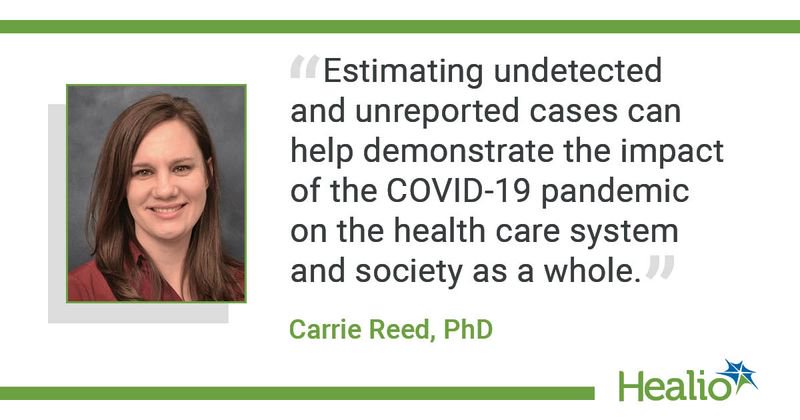Q&A: Model estimates 53M COVID-19 cases occurred through September in US
In a new modeling study, researchers estimated that nearly 53 million SARS-CoV-2 infections — including 2.4 million associated hospitalizations — may have occurred in the United States through September 30.
The analysis, which was published in Clinical Infectious Diseases, offers a more complete picture of the impact of the pandemic, in which approximately 6.9 million laboratory-confirmed cases were reported nationally during the same period. The estimate accounted for undetected and unreported infections, and it may be useful for informing mitigation and resource allocation efforts, researchers said.

Carrie Reed, PhD, a CDC epidemiologist, and colleagues used the model to adjust the reported number of confirmed COVID-19 cases for factors that could cause underdetection of SARS-CoV-2 infection, including test sensitivity — a similar method that was used to estimate the incidence of the 2009 influenza A(H1N1) pandemic. The researchers found that of the estimated 52.9 million COVID-19 cases captured in their model, 44.8 million were symptomatic.
Healio spoke with Reed about the implications the study may have for future COVID-19 surveillance efforts.
Q: What implications does this study have for public health monitoring? What do these results mean for clinicians?
A: Although case reports provide valuable data to help inform the on-the-ground public health response to the pandemic at a local level, the reported cases don’t capture all of the cases of COVID-19 in the country. These estimates provide a more complete assessment of the full impact of COVID-19 as of September 2020. Estimating undetected and unreported cases can help demonstrate the impact of the COVID-19 pandemic on the health care system and society as a whole, direct and allocate hospital resources, assist in planning — including vaccination plans — predict the future burden of COVID-19 cases and evaluate the potential impact of interventions.
Q: What improvements can be made to current reporting and monitoring practices for COVID-19?
A: The high numbers of infections throughout the United States have impacted the ability to complete detailed case reporting on all infections, including patient demographics and hospitalization status. For cases with missing hospitalization status, for example, we imputed the proportion of reported cases that were hospitalized from those with complete data, but it is unclear if that assumption could have overestimated or underestimated hospitalizations. Implementing a random sampling approach to get complete data on a smaller subset of reported cases may improve our ability to draw conclusions about the reported cases as a whole, the risk of severe illness and the most affected populations.
Q: Were there results from this study that surprised you? Which data and why?
A: Many respiratory viruses cause similar symptoms that are difficult to tell apart without laboratory testing. Testing rates for SARS-CoV-2 have improved over time, but there are still people presenting to health care in both the inpatient and outpatient settings with potential COVID-like diagnoses (eg, pneumonia, shortness of breath, cough illness and respiratory distress) who aren’t getting tested and diagnosed as COVID-19 cases. In addition, only about a third of people who reported through online surveys that they had a COVID-19-like illness say they sought out testing services or medical care. All of this highlights the potential for underreporting and the importance of having data to monitor health care seeking behaviors and clinical testing practices for patients with different clinical syndromes and in a variety of health care and geographic settings to better understand how much more disease may be going undetected.
Q: What limitations were there for this study, and how can they be addressed for future analysis?
A: These estimates of COVID-19 infections, symptomatic illnesses and hospitalizations are subject to several limitations. In the early stages of the COVID-19 pandemic, as is generally the case with the emergence of a novel virus like SARS-CoV-2, data on testing, detection and case reporting, which are necessary for estimating the true burden of a disease, were incomplete or not available. More specifically, in some heavily affected areas of the United States, the size of the COVID-19 outbreak quickly exceeded the capacity of health systems to complete detailed reporting on cases that included information like the age of the patient and whether or not they were hospitalized. This led to case reports sent to CDC that were missing vital patient information. The CDC had to estimate the age and hospitalization status of patients with missing data based on cases with known information on age and hospitalization status.
To inform how to make estimates of disease burden for COVID-19, we relied on our experiences estimating influenza disease burden. The CDC has been monitoring testing practices for influenza among hospitalized patients since 2010 to make estimates of annual disease burden of influenza in the United States. Nearly a decade of influenza data collection and analysis has shown respiratory disease testing varies in different parts of the country, by care settings, for different age groups and at differing levels of disease severity. The data available so far on COVID-19 testing practices are limited across these variables. Once more complete data across these variables are available, COVID-19 burden estimates will be updated on the CDC COVID-19 website.

